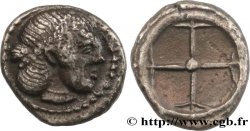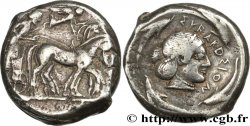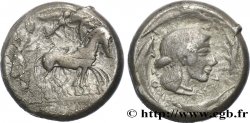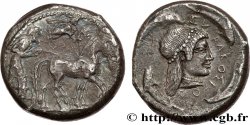bgr_350383 - SICILY - SYRACUSE Tétradrachme
Not available.
Item sold on our e-shop (2017)
Price : 2 200.00 €
Item sold on our e-shop (2017)
Price : 2 200.00 €
Type : Tétradrachme
Date: c. 475-470 AC.
Mint name / Town : Syracuse, Sicile
Metal : silver
Diameter : 24 mm
Orientation dies : 2 h.
Weight : 16,93 g.
Rarity : R2
Coments on the condition:
Exemplaire sur un petit flan épais et régulier, légèrement ovale, bien centré des deux côtés. Coin de droit légèrement bouché sur l’aurige et la roue du char, autrement bien venu à la frappe. Très jolie tête d’Aréthuse au revers, bien venue à la frappe, de style fin servie par une magnifique patine de médaillier avec des reflets mordorés
Catalogue references :
Bœhringer315 (A/151 - R/ 221) (3 ex.) - ANS.- - Randazzo Hoard470 - MIAMG.4873 var. (R2) (4500€) - Münich- - HGCS. 2/1307
Predigree :
Cet exemplaire provient de la vente iNumis 2, n° 6 et de la collection d’Élisabeth
Obverse
Obverse legend : ANÉPIGRAPHE.
Obverse description : Bige au pas à droite, conduit par un aurige tenant les rênes et le kentron ; le bige est couronné par Niké volant à droite.
Reverse
Reverse description : Tête d'Aréthuse à droite, les cheveux relevés et retenus par un diadème de perles, entourée de quatre dauphins.
Reverse legend : SU-RA-KOS-IO-N.
Reverse translation : (de Syracuse).
Commentary
Mêmes coins que l’exemplaire de l’American Numismatic Society et que l’exemplaire de la collection Weber n° 1582. Même coin de droit que l’exemplaire de la collection Jameson I, 746.








 Report a mistake
Report a mistake Print the page
Print the page Share my selection
Share my selection Ask a question
Ask a question Consign / sell
Consign / sell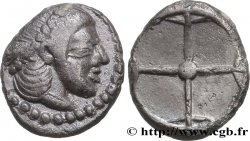
 Full data
Full data